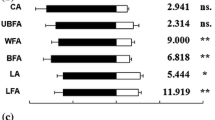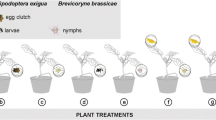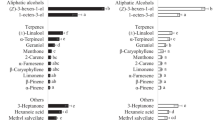Abstract
Volatiles emitted by plants in response to feeding by Lygus species were tested in neurophysiological, behavioral, and parasitism trials with Anaphes iole, an egg parasitoid of Lygus. Electroantennogram analyses indicated that A. iole antennae responded to most herbivore-induced plant volatiles (HIPVs) tested and that females were usually more responsive than males. Antennal responses to (Z)-3-hexenyl acetate and methyl salicylate were among the strongest. Behavioral assays in a four-arm olfactometer demonstrated that response of female wasps to (Z)-3-hexenyl acetate varied greatly depending on preconditioning regime. Preconditioning wasps to complex host-plant odors led to stronger preference than did a single preconditioning stimulus, i.e., (Z)-3-hexenyl acetate. In a horizontal wind tunnel, female wasps were attracted by methyl salicylate and α-farnesene. Parasitism of Lygus lineolaris eggs by A. iole in a cotton field was greater when the eggs were associated with (Z)-3-hexenyl acetate or α-farnesene than with controls. Overall, the results of this study show that A. iole can perceive a variety of plant volatiles released after its host damages plants, that the degree of associative learning in A. iole can be manipulated based on preconditioning regime, and that single synthetic HIPVs are attractive to A. iole and can be used to increase attack rates on host eggs. Therefore, it appears that HIPVs have potential for use in suppression of Lygus population densities.




Similar content being viewed by others
References
Backus, E. A., Cline, A. R., Ellerseick, M. R., and Serrano, M. S. 2007. Lygus hesperus (Hemiptera: Miridae) feeding on cotton: new methods and parameters for analysis of nonsequential electrical penetration graph data. Ann. Entomol. Soc. Amer. 100:296–310.
Birkett, A. M., Chamberlain, K., Guerrieri, E., Pickett, J. A., Wadhams, L. J., and Yasuda, L. 2003. Volatiles from whitefly-infested plants elicit a host-locating response in the parasitoid, Encarsia formosa. J. Chem. Ecol. 29:1589–1600.
Blackmer, J. L., Rodriguez-Saona, C., Byers, J. A., Shope, K. L., and Smith, J. P. 2004. Behavioral response of Lygus hesperus to conspecifics and headspace volatiles of alfalfa in a Y-tube olfactometer. J. Chem. Ecol. 30:1547–1564.
Bloem, K. A., and Yeargan, K. V. 1982. Host-finding behavior of Patasson lameerei, (Hym., Chalcidoidea), a parasitoid of Sitona eggs (Col., Curculionidae). Entomophaga 1:93–97.
Cobben, R. H. 1978. Evolutionary trends in Heteroptera. Part II. Mouthpart-structures and feeding strategies. Meded. Landbouwhogesch. Wageningen. 78–5:1–407.
Colazza, S., Mcelfresh, J. S., and Millar, J. G. 2004. Identification of volatile synomones, induced by Nezara viridula feeding and oviposition on bean spp., that attract the egg parasitoid Trissolcus basalis. J. Chem. Ecol. 30:945–964.
Conti, E., Jones, W. A., Bin, F., and Vinson, S. B. 1996. Physical and chemical factors involved in host recognition behavior of Anaphes iole Girault, an egg parasitoid of Lygus hesperus Knight (Hymenoptera: Mymaridae; Heteroptera: Miridae). Biol. Control 7:10–16.
Conti, E., Jones, W. A., Bin, F., and Vinson, S. B. 1997. Oviposition behavior of Anaphes iole, an egg parasitoid of Lygus hesperus (Heteroptera: Miridae; Hymenoptera: Mymaridae). Ann. Entomol. Soc. Amer. 90:91–101.
Dicke, M. 1999. Are herbivore-induced plant volatiles reliable indicators of herbivore identity to foraging carnivorous arthropods? Entomol. Exp. Appl. 91:131–142.
Dicke, M., Van baarlen, P., Wessels, R., and Dijkman, H. 1993. Herbivory induces systemic production of plant volatiles that attract predators of the herbivore: extraction of endogenous elicitor. J. Chem. Ecol. 19:581–599.
Drukker, B., Scutareanu, P., and Sabelis, M. W. 1995. Do anthocorid predators respond to synomones from Psylla-invested pear trees under field conditions? Entomol. Exp. Appl. 77:193–203.
Drukker, B., Bruin, J., and Sabelis, M. W. 2000. Anthocorid predators learn to associate herbivore-induced plant volatiles with presence or absence of prey. Physiol. Entomol. 25:260–265.
Du, Y.-J., Poppy, G. M., and Powell, W. 1996. Relative importance of semiochemicals from first and second trophic levels in host foraging behavior of Aphidius ervii. J. Chem. Ecol. 22:1591–1605.
Hilker, M., and Meiners, T. 2006. Early herbivore alert: insect eggs induce plant defense. J. Chem. Ecol. 32:1379–1397.
Hilker, M., Kobs, C., Varama, M., and Schrank, K. 2002. Insect egg deposition induces Pinus to attract egg parasitoids. J. Exp. Biol. 205:455–461.
Huber, J. T., and Rajakulendran, V. K. 1988. Redescription of and host-induced antennal variation in Anaphes iole Girault (Hymenoptera: Mymaridae), an egg parasite of Miridae (Hemiptera) in North America. Can. Entomol. 120:893–901.
Hunter, M. D. 2002. A breath of fresh air: beyond laboratory studies of plant volatile-natural enemy interactions. Agric. Forest Entomol. 4:81–86.
Jackson, C. G., and Graham, H. M. 1983. Parasitism of four species of Lygus (Hemiptera: Miridae) by Anaphes ovijentatus (Hymenoptera: Mymaridae) and an evaluation of other possible hosts. Ann. Entomol. Soc. Amer. 76:772–775.
James, D. G. 2003a. Field evaluation of herbivore-induced plant volatiles as attractants for beneficial insects: methyl salicylate and the green lacewing, Chrysopa nigricornis. J. Chem. Ecol. 29:1601–1609.
James, D. G. 2003b. Synthetic herbivore-induced plant volatiles as field attractants for beneficial insects. Environ. Entomol. 32:977–982.
James, D. G. 2005. Further field evaluation of synthetic herbivore-induced plant volatiles as attractants for beneficial insects. J. Chem. Ecol. 31:481–495.
James, D. G., and Price, T. S. 2004. Field-testing of methyl salicylate for recruitment and retention of beneficial insects in grapes and hops. J. Chem. Ecol. 30:1613–1628.
James, D. G., and Grasswitz, T. R. 2005. Synthetic herbivore-induced plant volatiles increase field captures of parasitic wasps. BioControl 50:871–880.
Kaiser, L., Perez-maluf, R., Sandoz, J. C., and Pham-delegue, M.-H. 2003. Dynamics of odour learning in Leptopilina boulardi, a hymenopterous parasitoid. Anim. Behav. 66:1077–1084.
Karban, R., and Baldwin, I. T. 1997. Induced Responses to Herbivory. Chicago University Press, Chicago.
Kovats, E. 1958. Gas-chromatographische Charakterisierung organisher Verbindungen. Helv. Chim. Acta 41:1915–1932.
Leigh, T. F., Kerby, T. A., and Wynholds, T. F. 1988. Cotton square damage by the plant bug, Lygus hesperus (Hemiptera: Heteroptera: Miridae), and abscission rates. J. Econ. Entomol. 81:1328–1337.
Loughrin, J. H., Manukian, A., Heath, R. R., and Tumlinson, J. H. 1995. Volatiles emitted by different cotton varieties damaged by feeding beet armyworm larvae. J. Chem. Ecol. 21:1217–1227.
Manrique, V., Jones, W. A., Williams, L. III, and Bernal, J. S. 2005. Olfactory responses of Anaphes iole (Hymenoptera: Mymaridae) to volatile signals derived from host habitats. J. Ins. Behav. 18:89–104.
Meiners, T., and Hilker, M. 1997. Host location in Oomyzus gallerucae (Hymenoptera: Eulophidae), an egg parasitoid of the elm leaf beetle Xanthogaleruca luteola (Coleoptera: Chrysomelidae). Oecologia 112:87–93.
Meiners, T., and Hilker, M. 2000. Induction of plant synomones by oviposition of a phytophagous insect. J. Chem. Ecol. 26:221–231.
Meiners, T., Westerhaus, C., and Hilker, M. 2000. Specificity of chemical cues used by a specialist egg parasitoid during host location. Entomol. Exp. Appl. 95:151–159.
Moraes, M. C. B., Laumann, R., Sujii, C. P., and Borges, M. 2005. Induced volatiles in soybean and pigeon pea plants artificially infested with the neotropical brown stink bug, Euschistus heros, and their effect on the egg parasitoid, Telenomus podisi. Entomol. Exp. Appl. 115:227–237.
Mumm, R., Tiemann, T., Varama, M., and Hilker, M. 2005. Choosy egg parasitoids: specificity of oviposition-induced pine volatiles exploited by an egg parasitoid of pine sawflies. Entomol. Exp. Appl. 115:217–225.
Ockroy, M. L. B., Turlings, T. C. J., Edwards, P. J., Fritzsche-hoballah, M. E., Ambrosetti, L., Bassetti, P., and Dorn, S. 2001. Response of natural populations of predators and parasitoids to artificially induced volatile emissions in maize plants (Zea mays L.). Agric. Forest Entomol. 3:201–209.
Paré, P. W., and Tumlinson, J. H. 1998. Cotton volatiles synthesized and released distal to the site of insect damage. Phytochemistry 47:521–526.
Randlkofer, B., Obermaier, E., M, and Einers, T. 2007. Mother’s choice of the oviposition site: balancing risk of egg parasitism and need of food supply for the progeny with an infochemical shelter? Chemoecology 17:177–186.
Rodriguez-Saona, C., Crafts-brandner, S. J., Paré, P. W., and Henneberry, T. J. 2001. Exogenous methyl jasmonate induces volatile emissions in cotton plants. J. Chem. Ecol. 27:679–695.
Rodriguez-Saona, C., Crafts-brandner, S. J., Williams, L. III, and Paré, P. W. 2002. Lygus hesperus feeding and salivary gland extracts induce volatile emissions in plants. J. Chem. Ecol. 28:1733–1747.
Rodriguez-Saona, C., Chalmers, J. A., Raj, S., and Thaler, J. S. 2005. Induced plant responses to multiple damagers: differential effects on an herbivore and its parasitoid. Oecologia 143:566–577.
Röse, U. S. R., Manukian, A., Heath, R. R., and Tumlinson, J. H. 1996. Volatile semiochemicals released from undamaged cotton leaves. Plant Physiol. 111:487–495.
Ruberson, J. R., and Williams, L. H. 2000. Biological control of Lygus spp.: a component of areawide management. Southwest. Entomol. Suppl. 23:96–110.
Santolamazza-Carbone, S., Illamola, A. R., and Rivera, A. C. 2004. Host finding and host discrimination ability in Anaphes nitens Girault, an egg parasitoid of the Eucalyptus snout-beetle Gonipterus scutellatus Gyllenhal. Biol. Control 29:24–33.
SAS INSTITUTE, INC. 2003. SAS/STAT User’s Guide, Release 9.1 edition. Cary, NC.
Schröder, R., Wurm, L., Varama, M., Meiners, T., and Hilker, M. 2008. Unusual mechanisms involved in learning of oviposition-induced host plant odours in an egg parasitoid? Anim. Behav. 75:1423–1430.
Shimoda, T., Takabayashi, J., Ashira, W., and Takafuji, A. 1997. Response of predatory insect Scolothrips takahashi towards herbivore induced plant volatiles under laboratory and field conditions. J. Chem. Ecol. 23:2033–2048.
Steinberg, S., Dicke, M., Vet, L. E. M., and Wanningen, R. 1992. Response of the braconid parasitoid Cotesia (=Apanteles) glomerata to volatile infochemicals: effects of bioassay set-up, parasitoid age and experience and barometric flux. Entomol. Exp. Appl. 63:163–175.
Thaler, J. S. 1999. Jasmonate-inducible plant defences cause increased parasitism of herbivores. Nature 399:686–688.
Tumlinson, J. H., Lewis, W. J., and Vet, L. E. M. 1993. How parasitic wasps find their hosts. Sci. Am. 268:100–106.
Turlings, T. C. J., Tumlinson, J. H., Heath, R. R., Proveaux, A. T., and Doolittle, R. E. 1991. Isolation and identification of allelochemicals that attract the larval parasitoid, Cotesia marginiventris (Cresson), to the microhabitat of one of its hosts. J. Chem. Ecol. 17:2235–2251.
Vet, L. E. M., and Groenewold, A. W. 1990. Semiochemicals and learning in parasitoids. J. Chem. Ecol. 16:3119–3135.
Vet, L. E. M., and Dicke, M. 1992. Ecology of infochemical use by natural enemies in a tritrophic context. Annu. Rev. Entomol. 37:141–172.
Vet, L. E. M., Van lenteren, J. C., Heymans, M., and Meelis, E. 1983. An airflow olfactometer for measuring olfactory responses of hymenopterous parasitoids and other small insects. Physiol. Entomol. 8:97–106.
Vet, L. E. M., Lewis, W. J., and Carde, R. T. 1995. Parasitoid Foraging and Learning, pp. 65–101, in R. Cardé, and W. J. Bell (eds.). Chemical Ecology of Insects 2Chapman & Hall, New York.
Wei, J., Wang, L., Zhu, J., Zhang, S., Nandi, O., and Kang, L. 2007. Plants attract parasitic wasps to defend themselves against insect pests by releasing hexenol. PLoS One 2(9):e852.
Wheeler, A. G. Jr. 2001. Biology of the Plant Bugs. Cornell University Press, Ithaca.
Williams, L. III, Rodriguez-Saona, C., Paré, P. W., and Crafts-brandner, S. J. 2005. The piercing-sucking herbivores Lygus hesperus and Nezara viridula induce volatile emissions in plants. Arch. Insect Biochem. Physiol. 58:84–96.
Zar, J. H. 1996. Biostatistical Analysis. 3rd edn.Prentice-Hall, Inc., Upper Saddle River, New Jersey.
Acknowledgments
We are grateful to D. A. Streett, A. C. Cohen, B. Woods, G. McCain, and D. A. Nordlund (USDA-ARS BCMRRU, Mississippi State, MS, USA) for supplying A. iole and L. lineolaris egg packs. The authors thank A. A. Faulkner, C. Li, and V. Manrique for technical assistance and J. L. Blackmer, J. M. Patt, L. L. Stelinski, and anonymous reviewers for critical and helpful comments on the manuscript. This article reports the results of research only. Mention of a proprietary product does not constitute an endorsement or a recommendation by the USDA for its use. The US Government has the right to retain a non-exclusive, royalty-free license in and to any copyright of this article.
Author information
Authors and Affiliations
Corresponding author
Rights and permissions
About this article
Cite this article
Williams, L., Rodriguez-Saona, C., Castle, S.C. et al. EAG-Active Herbivore-Induced Plant Volatiles Modify Behavioral Responses and Host Attack by An Egg Parasitoid. J Chem Ecol 34, 1190–1201 (2008). https://doi.org/10.1007/s10886-008-9520-5
Received:
Revised:
Accepted:
Published:
Issue Date:
DOI: https://doi.org/10.1007/s10886-008-9520-5




